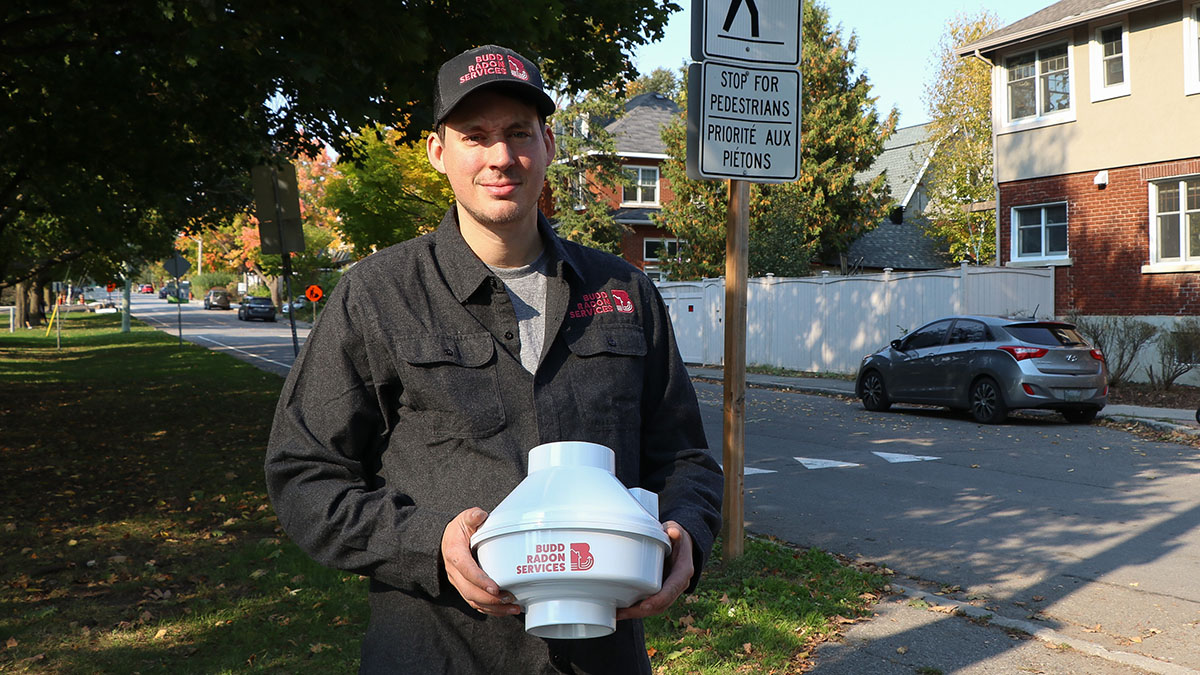With big plans to make his basement a playroom for his four children, Ottawa resident David Ramsey was not expecting a flyer from Health Canada to throw a wrench into the works.
Ramsey received the flyer in 2021, urging residents to test their houses for radon. Not having heard much about it, he decided to test his home. His results returned at 340 Bq/m³, 140 higher than the government-recommended maximum.
Radon results from the natural breakdown of uranium in rocks and soil, creating a colourless, odourless and tasteless gas. However, its health effects are not so invisible.
When inhaled, radon’s radioactive particles get trapped in the lungs and may cause cancer over time.
“We just had another kid and were looking to make the basement more of a playroom for the kids. We’re like, ‘radon, that’s not ideal,’ so we started looking into that,” Ramsey said.
Health Canada’s guideline for safe radon levels in a home is 200 Becquerels/m³ or lower. If a home has more than 600 Bq/m³, it is recommended to remediate within one year and if between 200-600 Bq/m³ within two years.
Ramsey’s familiarity with radon started when a family friend passed away from lung cancer, despite having no history of smoking. After passing, the family tested the house for radon and found high levels.
A 2024 Health Canada statistic showed that radon exposure may result in as many as 3,200 deaths annually, more than car accidents (1,898), carbon monoxide (300) and fire (109) deaths combined.
Pawel Mekarski, head of the radon technical operations section at Health Canada, explained that those who are exposed to radon long-term, which can be anywhere between five and 10 years, are at risk of developing lung cancer. However, there is a lag time following exposure.
“It obviously matters the level that you’re exposed to and the period of time. So, both those things are very important when looking at these kinds of cancers,” he said.
Mekarski explained that the program follows the recommendations of the World Health Organization (WHO).
WHO’s radon guidelines range between 100 to 300 Bq/m³ for national reference levels.
“The message we try to convey is not so much that 200 or below 200 is a safe level, [but] that any level of radon exposure carries risk,” Mekarski said.
A 2019 peer-reviewed research paper published in the Canadian Journal of Public Health, stated 90 per cent of Canadians spend their time indoors yet only 55 per cent have heard of radon and only six per cent take action.
Alex Budd, a local radon mitigator detected high levels of radon in his home and decided to mitigate it himself. He started his business not long after when he realized how little people knew about it.
“I decided to get into it to help out friends and family and then decided to start the business and help out others,” Budd said.
Radon is only a concern for an individual’s health when emitted in an enclosed space; a mitigation system provides an alternate route for radon to be released outside.
The system includes a long pipe that is drilled into the soil and leads to the roof or out through a side wall. The fan located in the pipe sucks out the contaminated air from the ground underneath the house and reroutes it outside.
Budd explained it’s only necessary for an individual to mitigate their home once. “It’s a permanent system that stays just like a furnace or like a hot water tank. As long as the fan is functional and hasn’t worn out and died, it’ll do the job.”
The main route of radon entry is when the foundation of a building has cracks, allowing it to flow into the home.
Ramsey consulted a lab to detect his levels and was sent a long-term detector by mail. It’s a plastic container with a plastic film on the inside and if radon is detected in the air, the film presents microscopic tracks.
“We put it on a little coffee table in our basement and after several months, sent it back to the lab and the result was 340 Bq/m³,” he said.
When Ramsey had his mitigation system implemented earlier this year, they removed the carpet in his basement where noticeable cracks in the concrete were present.
Ramsey and his family were concerned and explained that his “wife didn’t really want to work out down there anymore. So that encouraged us, plus the kids, to get the system done.”
Testing for radon is a fairly simple process. Concerned homeowners can buy an inexpensive test kit that would be put in a certain location and left for three months or more. People would then send the kit to a lab and await the results. People can also buy a radon monitor, a more expensive electronic device that monitors a space constantly.
The federal government recommends residents use a long-term test device for a minimum of three months during the fall, winter and spring to test for radon in homes.
“We have our houses typically the most closed up, we stay inside, [and] radon levels tend to be the highest during this time,” Mekarski said.
Budd said the at-home detectors are useful, especially after mitigation since residents are able to check their display at any point.
“Sometimes people don’t check that the fan’s still working and if they have that device on the wall, they can see that the levels are rising and then they look into it and see [if] the fan died,” Budd said.
The Health Canada website says about 10 per cent of homes will test above the guideline for radon. Mekarski mentioned there are resources residents can refer to on their website for more information on how to test and mitigate their homes.




